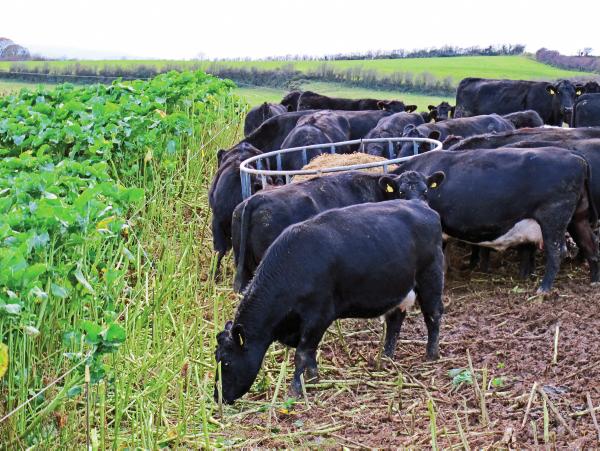Growing a successful catch crop can still be an option on farms not normally associated with free draining soils. Alternative forages, such as kale or rape, are usually grown for grazing throughout winter. But if grown properly, there is no reason that two or three acres of kale cannot be grazed in October to add an extra few weeks to the grazing season or stretch silage stocks.
It would also allow grass covers to build up for grazing sheep over winter or for early spring turnout.
Paul Turley is using kale and a hybrid crop, Redstart, to feed cattle throughout winter. Paul farms outside Downpatrick, Co Down, and his system revolves around grazing cattle 365 days of year.
While the farm is located in a drier region of the country, it still has plenty of issues with land being poached. There are no housing facilities or silage pits on the farm, just handling pens, so Paul has to conserve silage as bales and avail of forage crops, such as kale, to keep his system operational.
Why Grow Forage Brassicas?
Forage brassicas greatly reduce wintering costs. Feeding costs for Paul are running at £0.51/cow/day (€0.64/cow/day), compared with a 650kg cow eating 50kg of first cut silage at £30/tonne fresh (€37.50/tonne) costing around £1.50/day for forage only (€1.85/cow/day).
Paul sees kale as being less labour intensive, providing it is properly grown and utilised with infrastructure such as electric fencing is in place. Growing a brassica crop is a good opportunity to bring ground into a reseeding plan. It also makes greater use of cereal stubbles after harvesting increasing output/ha of land.
The most commonly grown brassicas are kale, forage rape or hybrid between the two. Trials in SAC and Grange show kale can support 0.7kg DLWG in weanlings. The crops are high in protein, meaning weanlings still keep growing in frame size, while milk production in suckler cows will be boosted in quality and yield.
Weanlings respond immediately to spring grass when normal grazing resumes.
An additional benefit is the improved health status of cattle as they are less likely to develop diseases normally associated with housing.
Growing & Management
Before growing, consider when do you want to feed the crop? Grazing is normally from October to March.
Once flowers are planted, it can no longer be grazed as it is poisonous to livestock. Typical sowing dates and grazing dates are outlined in Table 1.
This year, 45 acres of brassica crops have been planted by Paul, with 10 acres of the kale/rape hybrid Redstart sown together with a mix of oats, barley and peas. It was cut and baled on the last week of July. The crop yielded 10 bales/acre costing £23/bale to make (€28/bale). After cutting, the crop received two bags of CAN per acre and has successfully re-grown. This extra growth will give Paul another two to three weeks of forage for 70 cows and bull calves.
Cost of wintering
The costs of growing vary according to the sowing method and seed type. Hybrid varieties are more expensive than straight kale or rape. Sowing can be carried out by ploughing and broadcasting, burning off an existing crop and drilling, or direct drilling into the ground.
If ploughing in May, leaving ground fallow for a period so that weeds become established is a good idea. These can then be sprayed with glyphosphate and seed can be broadcast and rolled.
The cost for growing the brassica crop on Paul’s farm in 2012 is outlined in Table 2. As a general rule of thumb, one acre of kale will feed 30 suckler cows for a fortnight.
One acre of rape will feed the same group one week. Table 3 is a comparison of the daily feeding costs for a group of 30 cows grazing one acre of kale for one month compared with feeding in a shed on silage only. As the kale has a low fibre content, silage should be fed along with the crop. Paul is feeding approximately 50% kale and 50% silage to his cows, meaning that one acre of kale should last a group of 30 cows one month.
The other advantages that make growing kale worthwhile to Paul are:
With feeding costs almost £0.25/cow/day lower, this would result in a saving of £7.50/day for the group of 30 cows. The Turley farm is running 150 cows plus calves, meaning that the cows alone are saving £37.50/day for the herd (€47/day). On a 150-day winter, this amounts to £5,625 lower feed costs (€7,031).
Future Plans
Paul aims to sow kale one month later next year to have the crop at a lower height when starting to feed.
As utilisation will be higher, this will offset the lower yield. In addition, Paul hopes to get cattle onto the kale in early October, allowing him to close grazing ground up early. As his calving period begins in February, there is a large demand for grass in March.
While a crop like kale will not suit every farm in the country, as mentioned at the beginning of this article, there are some merits in growing two or three acres on more farms to get cattle off grass in October.
Even one month of grazing will preserve silage stocks and result in better grass covers for spring turnout.
It would also offer spring calves an opportunity to remain outdoors in the weeks after weaning, reducing the risk of respiratory diseases associated with housing.
Lessons Learned
As Paul only started his herd five years ago, he is continually learning and tweaking his system every year.
Some of the key lessons which Paul has learned are the following:
